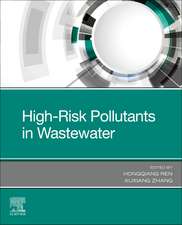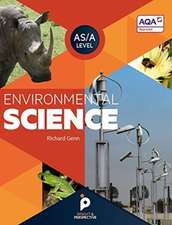Pesticides Remediation Technologies from Water and Wastewater
Editat de Mohammad Hadi Dehghani, Rama Rao Karri, Ioannis Anastopoulosen Limba Engleză Paperback – 26 apr 2022
This edited book provides the necessary basic knowledge to new researchers who want to learn about pesticides and the ways to eliminate them in aqueous matrices. Moreover, it is also a helpful resource for mature researchers in this field, providing them with new trends in water and wastewater treatment processes, preparation and application of novel adsorbent materials.
- Includes methods for effectively removing pesticides from potable water and water bodies
- Provides techniques that are eco-friendly and that do not use toxic chemicals and are lower in cost
- Presents information needed to identify severe health effects on human beings and aquatic animals
Preț: 727.32 lei
Preț vechi: 945.06 lei
-23% Nou
Puncte Express: 1091
Preț estimativ în valută:
139.18€ • 148.82$ • 116.04£
139.18€ • 148.82$ • 116.04£
Carte tipărită la comandă
Livrare economică 10-24 aprilie
Preluare comenzi: 021 569.72.76
Specificații
ISBN-13: 9780323908931
ISBN-10: 0323908934
Pagini: 462
Ilustrații: 90 illustrations (40 in full color)
Dimensiuni: 216 x 276 x 32 mm
Greutate: 1.07 kg
Editura: ELSEVIER SCIENCE
ISBN-10: 0323908934
Pagini: 462
Ilustrații: 90 illustrations (40 in full color)
Dimensiuni: 216 x 276 x 32 mm
Greutate: 1.07 kg
Editura: ELSEVIER SCIENCE
Cuprins
Section 1. Health effects of pesticides and its analytical techniques
1. Pesticides and its Human Health Implications
2. Presence, fate and transport of sulfonylurea herbicides in soils
3. Analytical methodologies and techniques for pesticide residue analysis
Section 2. Conventional treatment for the removal of pesticides
4. Conventional treatment for removal of pesticides from water and wastewater
Section 3. Advanced oxidation processes for the removal of pesticides
5. Advanced oxidation processes (AOPs) for removal of pesticides from water and wastewater
6. Recent aspects and modification in advanced oxidation processes for pesticide management in wastewater
Section 4. Membrane technology for the removal of pesticides
7. Membrane separation technology for removal of pesticides from water and wastewater
Section 5. Adsorption processes for the removal of pesticides
8. Basic fundamentals of Adsorption modelling for removal of pesticides from water and wastewater
9. New generation Adsorbents for removal of pesticides from water and wastewater
10. An overview on the removal of pesticides from water and wastewater through carbonaceous adsorbents
Section 6. Nanomaterials and Nanocomposites for the removal of pesticides
11. Remediation of Pesticides Residues from Contaminated Water using various Nanomaterials and Nanocomposites
12. Competence of Nanoparticle for Removal of Pesticides from Wastewater: An Overview
13. Advance remediation technologies for the removal of organochlorine from water and wastewater
14. Bioremediation of pesticides from water and wastewater
Section 7. Bioremediation for the removal of pesticides
15. Bioremediation and Phytoremediation of Pesticides Contaminated Aquatic Reserves- A Noval Approach
16. Bioremediation technologies for pesticides removal from wastewater: Strategies and challenges
17. Genotoxic Effects and Bacteria-Related Bioremediation of Pesticides
18. Soil toxicity and remediation techniques
19. Reclamation of groundwater polluted with pesticide residues using binary semiconductor materials under natural sunlight for its reuse in crop irrigation
1. Pesticides and its Human Health Implications
2. Presence, fate and transport of sulfonylurea herbicides in soils
3. Analytical methodologies and techniques for pesticide residue analysis
Section 2. Conventional treatment for the removal of pesticides
4. Conventional treatment for removal of pesticides from water and wastewater
Section 3. Advanced oxidation processes for the removal of pesticides
5. Advanced oxidation processes (AOPs) for removal of pesticides from water and wastewater
6. Recent aspects and modification in advanced oxidation processes for pesticide management in wastewater
Section 4. Membrane technology for the removal of pesticides
7. Membrane separation technology for removal of pesticides from water and wastewater
Section 5. Adsorption processes for the removal of pesticides
8. Basic fundamentals of Adsorption modelling for removal of pesticides from water and wastewater
9. New generation Adsorbents for removal of pesticides from water and wastewater
10. An overview on the removal of pesticides from water and wastewater through carbonaceous adsorbents
Section 6. Nanomaterials and Nanocomposites for the removal of pesticides
11. Remediation of Pesticides Residues from Contaminated Water using various Nanomaterials and Nanocomposites
12. Competence of Nanoparticle for Removal of Pesticides from Wastewater: An Overview
13. Advance remediation technologies for the removal of organochlorine from water and wastewater
14. Bioremediation of pesticides from water and wastewater
Section 7. Bioremediation for the removal of pesticides
15. Bioremediation and Phytoremediation of Pesticides Contaminated Aquatic Reserves- A Noval Approach
16. Bioremediation technologies for pesticides removal from wastewater: Strategies and challenges
17. Genotoxic Effects and Bacteria-Related Bioremediation of Pesticides
18. Soil toxicity and remediation techniques
19. Reclamation of groundwater polluted with pesticide residues using binary semiconductor materials under natural sunlight for its reuse in crop irrigation



























